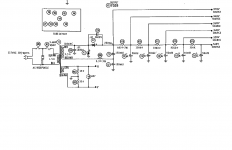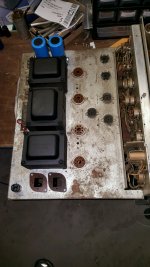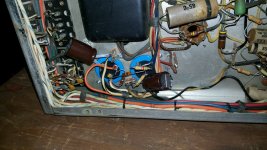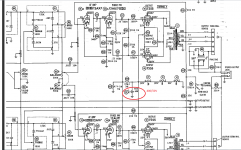Just acquired a rough A50K needs completely restoration. It is missing all the tubes.
Since the phenolic twist lock bases on both C3 and C4 (50mF 450V) are broken. Thought replacing these caps with JJ style capacitors. Any thoughts on best value for a pair of capacitors and mounts?
Since the phenolic twist lock bases on both C3 and C4 (50mF 450V) are broken. Thought replacing these caps with JJ style capacitors. Any thoughts on best value for a pair of capacitors and mounts?
The 7355 output tunes can be replaced with Sovtek 7591XYZ or equivalent with a small, backwards compatible change to the socket wiring. Jim McShane sells a restoration kit for these as well.
Concerning the power supply capacitors C3 and C4(50uF/450V). I am thinking of securing the caps temporarily to ensure that none of the connections come in contact with the chassis and try to power it up with these capacitors?
While inspecting these capacitors it was noticed that the ground for one of the capacitors had fractured off. I assume these grounds were to ground the metal case of the capacitor. This will be soldered back in place before any power is put to the amp.
There will be some cost and labor to replace the caps and the amp has not had any power put to it.
Can I check between the positive connections and the negative to ensure no short is present and try to put power to it using the light bulb?
Want to verify the transformers are not shorted or open?
Replaced the fuse holder last night so a fuse can be used. Will be replacing the power cord.
While inspecting these capacitors it was noticed that the ground for one of the capacitors had fractured off. I assume these grounds were to ground the metal case of the capacitor. This will be soldered back in place before any power is put to the amp.
There will be some cost and labor to replace the caps and the amp has not had any power put to it.
Can I check between the positive connections and the negative to ensure no short is present and try to put power to it using the light bulb?
Want to verify the transformers are not shorted or open?
Replaced the fuse holder last night so a fuse can be used. Will be replacing the power cord.
another question should the power cord be replaced with original two pole or should it be replaced with a three pole with the ground connection?
Resoldered ground on C3 and also the plate voltage for V4 from C4.
Secured caps temporarily so power could be applied.
Powered up amp with light bulb. Powered up okay.
Thought I could smell the psu caps heating up?
Measured 140VAC on psu transformer secondary but no B+ voltages were present at caps.
With the amp on the light bulb would the psu filter caps charge?
Purchased new psu filter caps and will install before powering up without light bulb. Will power up on variac?
Secured caps temporarily so power could be applied.
Powered up amp with light bulb. Powered up okay.
Thought I could smell the psu caps heating up?
Measured 140VAC on psu transformer secondary but no B+ voltages were present at caps.
With the amp on the light bulb would the psu filter caps charge?
Purchased new psu filter caps and will install before powering up without light bulb. Will power up on variac?
Okay just thinking the psu filter cap scenario over. I purchased two ARS 50uF/50uF 500V capacitors.
The ARS has the two 50uF taps required of C3.
C4 requires 3 50uF taps so I will still have to purchase an additional 50uF cap and solder in at bottom of C4?
The ARS has the two 50uF taps required of C3.
C4 requires 3 50uF taps so I will still have to purchase an additional 50uF cap and solder in at bottom of C4?
Attachments
Hi Bob,
Don't waste your time with the Sovtek tube & kit, you can buy the real thing in Electroharmonix, 7591EH. I recently bought a quad, all matched,in Canada.
Yes, check for shorts with your meter. Also, replace all B+ caps with total removal of the originals (don't use the original capacitor terminals as tie points). The multi-section capacitors you bought are fine. They are attached with clamps that screw into the chassis and have a band to tighten them with. Most suppliers also have these clamps for sale. If in doubt, call them and ask.
Replace all the grid coupling capacitors before trying anything. Certainly before installing tubes! Use the proper axial capacitors, not the "orange drop" types that are radial capacitors. They will not fit in the same spot as the originals. Make sure all your new components fit and leads run exactly like the original ones did. Lead dress is important with tube amplifiers, and you can change the sound, hum levels and even oscillation some times if the parts don't sit the way they ought to.
You should be seeing B+ voltages, but they will all be too high without a load. Before powering up again, replace the existing rectifiers with silicon diodes. 1N4007 would work great, but you need to add some series resistance to drop the loaded voltage to its proper level as stated on the schematics. Just worry about the first voltage reading as the others depend on the loads that are on them. Set your variac to 120 VAC or to whatever the voltage in your area normally is.
After checking for shorts, etc, smell all the transformers. If you smell one that smells burnt - sweet, there is a high chance that transformer was damaged. Keep your eye on it - and any tubes if it is an output transformer. Look also for level differences between outputs if an output transformer smells bad.
If everything checks at this point in time, replace all the other coupling capacitors and check the resistors for proper resistance. Replace those that are out of spec. If replacing a resistor, make certain that the replacement can handle the voltages in that amplifier. Obviously a grid resistor, and most cathode resistors will never see anything above 100 VDC, but the others may well see a lot more, like full B+. Some resistors have breakdown ratings as low as 50 VDC! Check, be sure.
-Chris
Don't waste your time with the Sovtek tube & kit, you can buy the real thing in Electroharmonix, 7591EH. I recently bought a quad, all matched,in Canada.
Yes, check for shorts with your meter. Also, replace all B+ caps with total removal of the originals (don't use the original capacitor terminals as tie points). The multi-section capacitors you bought are fine. They are attached with clamps that screw into the chassis and have a band to tighten them with. Most suppliers also have these clamps for sale. If in doubt, call them and ask.
Replace all the grid coupling capacitors before trying anything. Certainly before installing tubes! Use the proper axial capacitors, not the "orange drop" types that are radial capacitors. They will not fit in the same spot as the originals. Make sure all your new components fit and leads run exactly like the original ones did. Lead dress is important with tube amplifiers, and you can change the sound, hum levels and even oscillation some times if the parts don't sit the way they ought to.
You should be seeing B+ voltages, but they will all be too high without a load. Before powering up again, replace the existing rectifiers with silicon diodes. 1N4007 would work great, but you need to add some series resistance to drop the loaded voltage to its proper level as stated on the schematics. Just worry about the first voltage reading as the others depend on the loads that are on them. Set your variac to 120 VAC or to whatever the voltage in your area normally is.
After checking for shorts, etc, smell all the transformers. If you smell one that smells burnt - sweet, there is a high chance that transformer was damaged. Keep your eye on it - and any tubes if it is an output transformer. Look also for level differences between outputs if an output transformer smells bad.
If everything checks at this point in time, replace all the other coupling capacitors and check the resistors for proper resistance. Replace those that are out of spec. If replacing a resistor, make certain that the replacement can handle the voltages in that amplifier. Obviously a grid resistor, and most cathode resistors will never see anything above 100 VDC, but the others may well see a lot more, like full B+. Some resistors have breakdown ratings as low as 50 VDC! Check, be sure.
-Chris
Changed the meter from AC to DC and have high voltage all over. Was able to pick up a complete set of GE 5751 tubes, similar to 12AX7, but have 30% less gain ($5 ea) and a 12AU7. I am trying to assemble a complete set of tubes to perform chassis check. Still looking for a set of outputs. Have all psu caps on order. Want to replace psu caps before removing light bulb.
Last edited:
Hi Bob,
How about the grid coupling capacitors? Make the old ones all go away. A leaky coupling cap can destroy a tube, signal or power.
Yes, the 5751 is only just similar to the 12AX7. Characteristics are a little different too. They will make noise though. If it starts working, stuff some real 12AX7's in it. The 5751 might be okay to practice with. If you like the tone, you can keep them in there.
-Chris
How about the grid coupling capacitors? Make the old ones all go away. A leaky coupling cap can destroy a tube, signal or power.
Yes, the 5751 is only just similar to the 12AX7. Characteristics are a little different too. They will make noise though. If it starts working, stuff some real 12AX7's in it. The 5751 might be okay to practice with. If you like the tone, you can keep them in there.
-Chris
Making headway on the power supply filtering caps. The 50uF/50uF/50uF 450V multi section caps replaced with 50uF/50uF 450V ARS caps with a 50uF 450V under chassis mounted underneath. The hard wiring is a pain in the behind compared to pulling and replacing a board mounted component.
Finishing up the work on the 150uF 250V filtering caps. The paper insulated caps will be left in place while the new caps will be mounted under the chassis. Had to replace the insulated 4 tab twist can mounts....they were broken.
Finishing up the work on the 150uF 250V filtering caps. The paper insulated caps will be left in place while the new caps will be mounted under the chassis. Had to replace the insulated 4 tab twist can mounts....they were broken.
Attachments
Hi Bob,
As long as the original capacitors are electrically disconnected, you shouldn't have any problems. I've stuck the new parts inside the old cans when there wasn't room for anything else under the chassis.
-Chris
As long as the original capacitors are electrically disconnected, you shouldn't have any problems. I've stuck the new parts inside the old cans when there wasn't room for anything else under the chassis.
-Chris
Get rid of all those original caps. I've been using the yellow cornell's with a lot of luck in my A500 after I had a few that started getting intermittent on me. Mine looked in OK shape but noticed a pretty significant increase in clarity after getting rid of them. I also had issues with a few of the ceramic caps found all over, opted to replace those as well.
Another area of problem were the "all in one" packages that they used for the tone controls and in other places throughout. Replace those with some discrete components. I also opted to remove the normal/reverse stereo and some other features that I never used to cut down on wiring and just general junk floating around.
Those are pretty much the big ones, my A500 is still in a state of repair, I got sucked into another project and will come back once I get it done. An additional option is to replace the output tubes with some 5881's or EL34's but that will require some additional re-wiring and new bias values...so forth. Lastly if you can, get rid of the heaters in the output tube bias for some additional benefits by making a new Vreg for the bias and then finding somewhere to put your heaters.
And ditto on the 5751's. I put some "cheap" ELH12AX's in mine to get everything going and will plan on putting in some 12ax7LPS in once it all gets squared away. The ELH weren't bad and you really couldn't tell at normal listening volumes so I may just toss the LPS in the phono stage and call it done. We'll see once I get there 😀
Another area of problem were the "all in one" packages that they used for the tone controls and in other places throughout. Replace those with some discrete components. I also opted to remove the normal/reverse stereo and some other features that I never used to cut down on wiring and just general junk floating around.
Those are pretty much the big ones, my A500 is still in a state of repair, I got sucked into another project and will come back once I get it done. An additional option is to replace the output tubes with some 5881's or EL34's but that will require some additional re-wiring and new bias values...so forth. Lastly if you can, get rid of the heaters in the output tube bias for some additional benefits by making a new Vreg for the bias and then finding somewhere to put your heaters.
And ditto on the 5751's. I put some "cheap" ELH12AX's in mine to get everything going and will plan on putting in some 12ax7LPS in once it all gets squared away. The ELH weren't bad and you really couldn't tell at normal listening volumes so I may just toss the LPS in the phono stage and call it done. We'll see once I get there 😀
Completed the recap of the power supply filter caps. Have the light bulb off of it now and powering it directly plugged into 115V, no problems. The measured voltage at the transformer secondary is 190 volt (should be 145V) and the B + voltage is 430V (should be 370V). I assume the voltage
Will drop when the tubes are installed.
Will it be possible to install one of the 12ax7 preamp tubes in it to see if it will glow or do all the preamp tubes have to be installed or do all the tubes have to be in it, is it possible to check one tube at a time?
Will drop when the tubes are installed.
Will it be possible to install one of the 12ax7 preamp tubes in it to see if it will glow or do all the preamp tubes have to be installed or do all the tubes have to be in it, is it possible to check one tube at a time?
Just observed that one of the 50uF/450V needs to be a 400uF/50V. Luckily it happened to be the cap installed under the chassis...easy to replace. Seems to be an odd animal.
Hi Bob,
The tubes are all in parallel. But, you should never apply full power to a tube amp without the output tubes installed. As you can see, the voltages are far too high.
Hi jlangholzj,
Why on earth would you want to replace the output transformers and the output tubes?? I assume you have also planned for a new power transformer to look after the higher heater current draw? Why the output transformers? Because they are not the correct ones for the other tubes you mentioned.
Rock guitarists may not like the Electroharmonix tubes, although I know some who love them (in Fender Twins and similar). They are extremely consistent in characteristics and darned quiet too. You're throwing stones at the wrong tube line. They are some of the best tubes out there. Never mind that the 6L6EH survives in Fender amplifiers when most other tubes have gone all cherry red ...
One thing people have got to come to grips with is that a tube doesn't have a sound unless it crackles, hisses, rings or hums (just before it expires). The sound you get is the reaction of the characteristics of the tube against the elements of the circuit design. Get a circuit not designed properly and all bets are off when it comes to which tube sounds the best. But circuits designed for a real 12AX7 (say) will have the lowest distortion and sound the best with a tube that matches the boogey 12AX7A (they are all A's = 7025 these days) tube. So that would include NOS RCA manufactured tubes and Electroharmonix along with other high quality tubes. The real bonus is that Electroharmonix tubes have great manufacturing quality and consistency. I have been using them ever since they were introduced and have never been sorry I have. I do service work BTW.
-Chris
The tubes are all in parallel. But, you should never apply full power to a tube amp without the output tubes installed. As you can see, the voltages are far too high.
Hi jlangholzj,
Why on earth would you want to replace the output transformers and the output tubes?? I assume you have also planned for a new power transformer to look after the higher heater current draw? Why the output transformers? Because they are not the correct ones for the other tubes you mentioned.
Rock guitarists may not like the Electroharmonix tubes, although I know some who love them (in Fender Twins and similar). They are extremely consistent in characteristics and darned quiet too. You're throwing stones at the wrong tube line. They are some of the best tubes out there. Never mind that the 6L6EH survives in Fender amplifiers when most other tubes have gone all cherry red ...
One thing people have got to come to grips with is that a tube doesn't have a sound unless it crackles, hisses, rings or hums (just before it expires). The sound you get is the reaction of the characteristics of the tube against the elements of the circuit design. Get a circuit not designed properly and all bets are off when it comes to which tube sounds the best. But circuits designed for a real 12AX7 (say) will have the lowest distortion and sound the best with a tube that matches the boogey 12AX7A (they are all A's = 7025 these days) tube. So that would include NOS RCA manufactured tubes and Electroharmonix along with other high quality tubes. The real bonus is that Electroharmonix tubes have great manufacturing quality and consistency. I have been using them ever since they were introduced and have never been sorry I have. I do service work BTW.
-Chris
Just acquired a rough A50K needs completely restoration. It is missing all the tubes.
Since the phenolic twist lock bases on both C3 and C4 (50mF 450V) are broken. Thought replacing these caps with JJ style capacitors. Any thoughts on best value for a pair of capacitors and mounts?
I have some brand new and used GE 7355 if you are interested. Just email me off site. cheers!
difficult sourcing a 400uF/50V. Any concerns with putting a 470uF/50V where marked?
That cap will be just fine in the spot you indicated. You can go twice as much capacitance even more with no problem. Caps of that era were much larger which was the deciding factor back then. Since that cap is part of the 7355 power tube cathodes you should use a high quality electrolytic like Elna Cerafine, Nichicon Muse, etc. I don't know what values are available in those brands, but you should be able to get 470 x 50v. Check Handmade audio, Michael Percy, etc..
Last edited:
I'd think the extra 70u isn't going to hurt you any. I ended up having to play with some values as well as some of the originals were not what we would call "standard values".
Where did I say anything about replacing an output trafo? I've come across a great many folks using both the EL34 or a 5881 with the original HK iron and have had good results.
As far as the output tubes, only reason being for replacement is that a matched quad of 7355's is somewhere around the $150-$230 vs some of the alternatives are about half of that. OP said they've got none of the tubes so I was simply offering another common change that would give options for not only future-proofing the amplifier but also something that would be a bit lighter on budget.
And yes, there are changes and additions that needed to be made for EVERYTHING that I said and I didn't go into full detail on it because well, its all readily available and if OP was really interested, either a) they could find the prerequisites or b) I'm all ears!
Hi Bob,
Hi jlangholzj,
Why on earth would you want to replace the output transformers and the output tubes?? I assume you have also planned for a new power transformer to look after the higher heater current draw? Why the output transformers? Because they are not the correct ones for the other tubes you mentioned.
Where did I say anything about replacing an output trafo? I've come across a great many folks using both the EL34 or a 5881 with the original HK iron and have had good results.
As far as the output tubes, only reason being for replacement is that a matched quad of 7355's is somewhere around the $150-$230 vs some of the alternatives are about half of that. OP said they've got none of the tubes so I was simply offering another common change that would give options for not only future-proofing the amplifier but also something that would be a bit lighter on budget.
And yes, there are changes and additions that needed to be made for EVERYTHING that I said and I didn't go into full detail on it because well, its all readily available and if OP was really interested, either a) they could find the prerequisites or b) I'm all ears!
- Home
- Amplifiers
- Tubes / Valves
- Harmon Kardon A50K project



